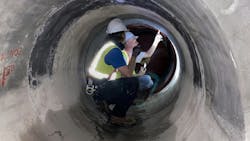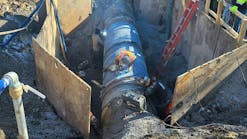Houston, Texas is one of the largest cities in America, and there are no signs the population growth is slowing down any time soon.
The city is now the second-fastest growing metro area in the country, according to the U.S. Census. With an increasing population and other challenges, such as subsidence, the city is hyper-focused on resiliency to ensure its infrastructure is ready and prepared for the future.
To ensure the city can continue to effectively provide vital water resources for Houston’s growing population, the Public Works Department has been taking a comprehensive look at its water infrastructure. City project managers want to know where it can improve and where it can expand.
Aging infrastructure amid growth
Currently, the city is in the midst of expanding two of its three major water plants, one of which is the Northeast Water Purification Plant (NEWPP) which is being expanded to strengthen its water treatment capacity. The primary objective is to accommodate future water demands and curtail reliance on groundwater, which has led to land subsidence in the region.
Once completed, the NEWPP's treatment capabilities will increase daily treatment capacity to 320 million gallons and provide more potable drinking water to the growing suburbs on the north and west sides of the city. That is expected by 2025.
It’s not only the suburbs that are growing. With a revitalized metro center, Houston’s downtown is as well. Much of the infrastructure that transmits water to the downtown area was constructed in the 1970s and 80s — back when residents were still wearing Houston Oiler blue jerseys and Nolan Ryan was pitching at the Astrodome.
These days, the city is home to the pennant-winning Astros and the growth has not stopped. In 2024, Houston is poised to retain the title of fourth largest city in the U.S. behind Los Angeles, New York City, and Chicago.
While some of the aging infrastructure is reaching the end of its designed life, it is impractical to believe that every single pipeline, pump station or storage tank can be replaced. Not only would it be incredibly expensive to replace all of this infrastructure at once, it would also not be cost-effective because existing infrastructure can be rehabilitated and have its life extended.
With new technologies emerging and the city capturing federal funds for local infrastructure improvements, it can implement a host of viable options to keep infrastructure resilient.
An asset assessment program
For Houston Public Works, resiliency in infrastructure is why they have developed the Transmission Line Condition Assessment and Rehabilitation Program (TLCARP). A prime example of this program is the 60-inch prestressed pipeline that extends from the East Water Purification Plant (EWPP), which carries potable drinking water into downtown Houston.
The pipeline, commonly referred to as The North 60 Line, was constructed in the 1970s. Since the city relies heavily on this pipeline artery, and because of its age, the line was selected for a condition assessment under Houston’s TLCARP initiative.
“These condition assessments not only preserve the function of existing infrastructure from sudden failures but keep the city vigilant and well-prepared in the case of a catastrophic failure,” says Panduranga Kuruva, PE, MBA, a managing engineer with the city of Houston.
Consulting engineers are helping Houston Public Works on this work, as well as several other TLCARP scopes, by designing and managing condition assessment projects.
“LAN, the city’s consulting engineer, has been very instrumental on many occasions in managing and documenting these projects,” says Kuruva. “Keeping the city informed of the prevailing condition of the infrastructure, by periodically providing a repository of the existing and deteriorating conditions, is important.”
Evaluating the North 60 Line
The North 60 Line is composed of mostly pre-stressed concrete cylinder pipe (PCCP). PCCP is a high-strength pipe that has long been a first-choice pipe material for contractors building drinking water transmission lines. The pipe’s strength comes from tensioned wire wrapping around a steel cylinder that’s encased in concrete.
As these tensioned wires age, they can fail. Among other factors, failures can result from corrosion, changes in the flow rate, excessive external forces or weights on the pipe, ground movement, temperature fluctuations, fatigue and age-related degradation. Pinhole or joint leaks can also increase the risk of damage to the wire.
If not repaired, there can be a catastrophic system failure.
There are a few ways to determine if a pipeline has experienced this wire damage. Electromagnetic testing and acoustic fiber optic (AFO) cables are the two common ways used to evaluate and monitor the wire in an existing PCCP pipeline.
For this work, contractors utilize special equipment inside the pipe to employ electromagnetics, inducing a magnetic field to identify a broken segment of wire. This data is compiled, and repairs are made based on the structural analysis of the pipe segment. Regular AFO monitoring is crucial to detect these issues and prevent potential ruptures.
In general, after performing an electromagnetic inspection, AFO cables can be installed within the line so that wire wraps can be continuously monitored. The AFO technology is an efficient solution for identifying when and where a pre-stressed wire is broken.
The city did this with the North 60, after the previous assessment in 2012. These AFO cables monitor for changes or breaks by effectively listening for sonic anomalies. These breaks are then tracked and used in conjunction with previous inspection results to continually monitor the structural integrity of the pipeline.
When a pipe segment reaches the point of structural concern, the city can be proactive and rehabilitate structurally compromised segments. An example of this occurred during the planned assessment of the 60-inch pre-stressed pipe.
Identifying and rehabilitating aging pipe
On this particular 60-inch line, which lies underneath a busy downtown corridor, the city needed to act on previous 2003 inspection results and get an updated “snapshot” of the pipeline's condition. To optimize time and resources, the below-ground evaluation coincided with a pre-planned "shutdown" for the installation of a new 72-inch interconnection.
During a planned shutdown to assess and repair an interconnection, the AFO system recorded additional wire breaks on a pipe segment farther east along the alignment, near South Wayside Drive. This segment was at risk of failing, prompting the city to act immediately.
Since a team consisting of specialty contractors, design engineers, and local prime contractors were already planning a manned entry and re-assessment of this approximately 10,000 linear feet of 60-inch pre-stressed pipe to be performed in 2021, modifications were made to include additional footage for shutdown and dewatering in order to make a repair.
For the newly identified segment at risk, a carbon fiber-reinforced polymer lining (CFRP) was selected as the best way to rehabilitate the pipe. The same method is already being used with the portions of damaged pipe that were expected to be identified with the 2021 inspection limits. For CFRP repairs, epoxy resin is applied to sheets of carbon fiber, above ground, in a controlled environment, which is then applied inside the pipe in overlapping sheets.
After curing, the compromised segments are reliable once again. The CFRP now becomes a new internal lining capable of carrying all of its existing loads. These repairs are crucial to extending the life of a pipeline and bringing it in line with current codes.
“These kinds of repairs extend the life of the pipe to ensure a more resilient Houston. These polymers are not only durable but feasible to construct with minimal disturbance above ground, including traffic operations,” says Kuruva.
After rehabilitation, the pipe’s design life is typically extended by another 50 years. The cost to repair a single segment using CFRP can be in the range of $100,000; replacing an entire line is much more expensive.
Houston keeps its water infrastructure resilient
The technologies utilized in this project highlight just one way the city of Houston’s Public Works Department is working to find solutions to remedy any aging infrastructure. The North 60 project, along with other investments in water infrastructure, are keeping the city’s systems resilient, and most importantly able to contend with the growth it is experiencing.







